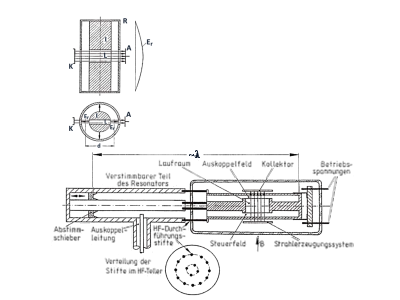History of Klystron

Figure 1: The Heil Generator (coaxial-line oscillator)
History of Klystron
1935The idea of a velocity modulated tube as microwave oscillator was first described by Agnessa Arsenjewa-Heil and Oskar Heil in a paper published in Germany.[1]
1935William Webster Hansen, Associate Professor Physics at Stanford University, invented the microwave cavity resonator. He named his resonators “rumbatrons”.
1937Using these “rumbatrons”, Russell and Sigurd Varian constructed several successful models of a two-cavity oscillator (two-cavity tube with feedback from the second to the first cavity) as the first modern microwave tube.[2] It was named “klystron” after the ancient Greek verb κλύζω (klyzo) indicating waves washing on a shore. But at this time it was too low-powered to be of interest for radar.
1938The Sheet-Beam Klystron was proposed by Vadim F. Kovalenko (USSR)
1939Oskar Heil completed the development of his microwave oscillator in the company Standard-Lorenz in Berlin. It was named to “Heil-tube” in Germany after its inventor. The Germans used his tubes in WWII.
1940The reflex version of the klystron was invented by R.V. Sutton (England) and independently by N.D. Devyatkov and V.F. Kovalenko (USSR).
1941The reflex klystron served as the local oscillator in superheterodyne radar receivers.
1948The Stanford klystron with three cavities and a wound-on beam-focusing electromagnet, reached a power output of 30 MW with 1-microsecond pulses. Klystrons could now be designed to power transmitters for radar.
1984The klystron with the ever highest pulse power was built.[3] It was developed in Stanford Linear Accelerator Center and provides 150 megawatts in S-Band.
Sources and ressorces:
- Agnessa Arsenjewa-Heil und Oskar Heil, “Eine neue Methode zur Erzeugung kurzer, ungedämpfter elektromagnetischer Wellen großer Intensität,” Zeitschrift für Physik, November 1935 p. 752 – 762.
- R. H. Varian: U.S. Patent No. 2.242.275 (Applied for, October 11, 1937)
- G. T. Konrad, “High-Power RF Klystrons for Linear Accelerators.” Invited paper, Linear Accelerator Conference, Darmstadt, West Germany, May 1984. (online)
